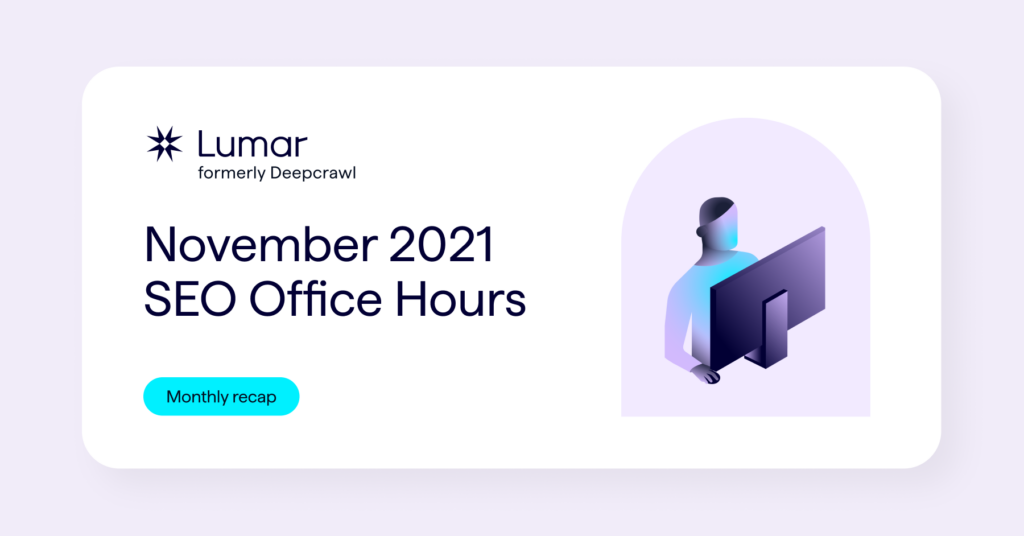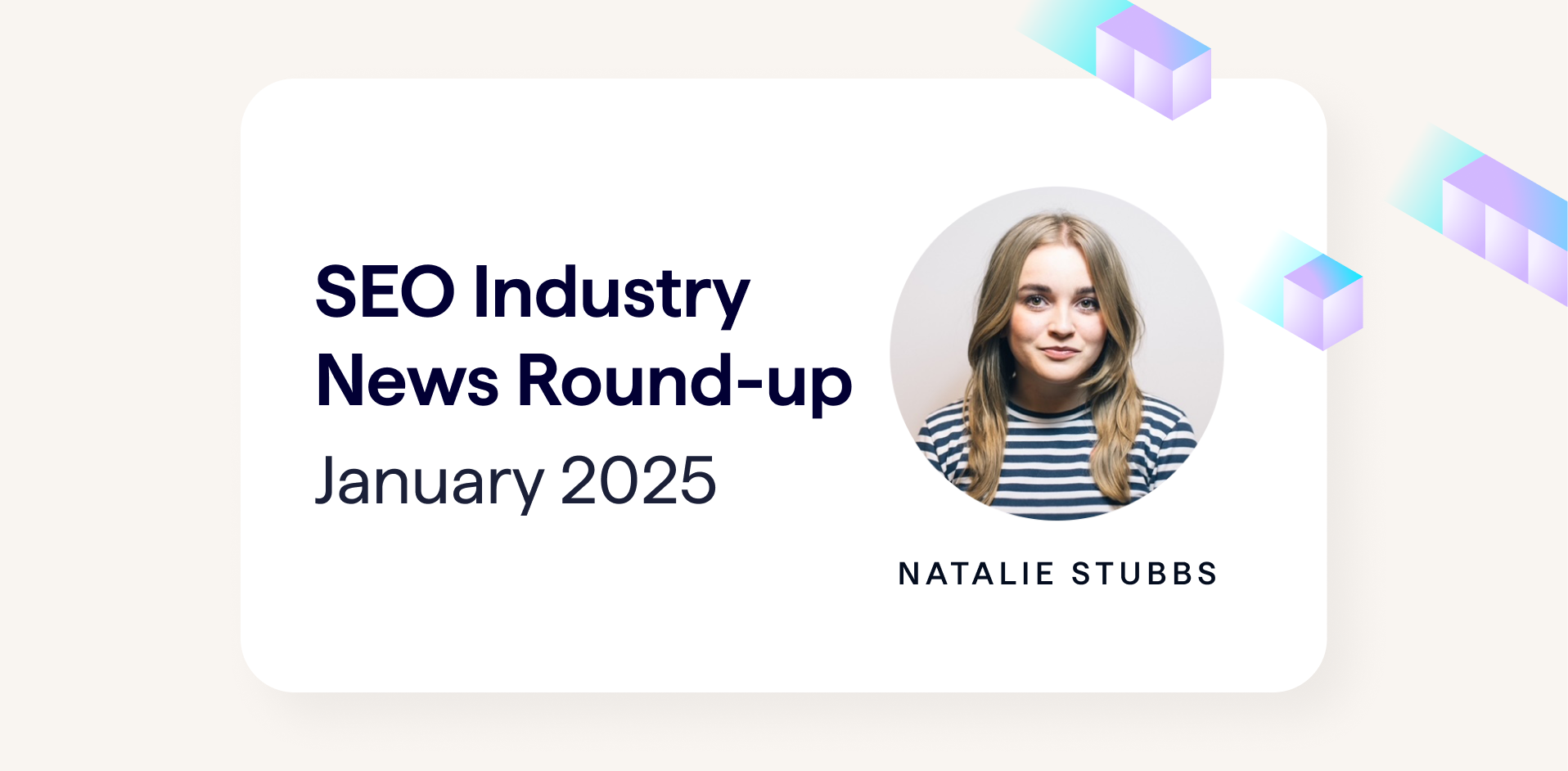—
About this blog series: Our team here at Lumar (formerly Deepcrawl) regularly attends Google Search Central‘s SEO Office Hours events. Even better: to help SEOs and marketers stay informed on the latest developments in organic search and find up-to-date, straight-from-the-source advice from Google’s search experts, we’re sharing our notes.
Read on for our top takeaways from the November 2021 sessions thus far.
Speed up recrawling of previously noindexed pages by temporarily linking to them on important pages
Temporarily internally linking to previously noindexed URLs on important pages (such as the homepage) can speed up recrawling of those URLs if crawling has slowed down due to the earlier presence of a noindex tag. The example given was of previously noindexed product pages and John’s suggestion was to link to them for a couple of weeks via a special product section on the homepage. Google will see the internal linking changes and then go and crawl those linked-to URLs. It helps to show they are important pages relative to the website. However, he also stated that if significant changes are made to internal linking, it can cause other parts of your site which are barely indexed to drop out of the index—this is why he suggests using these links as a temporary measure to get them recrawled at the regular rate, before changing it back.
Skip directly to this segment of the conversation below:
Having a high ratio of noindexed URLs vs. indexable URLs could potentially affect crawlability
Having noindex URLs normally does not affect how Google crawls the rest of your website—unless you have a large number of noindexed pages that need to be crawled in order to reach a small number of indexable pages.
John gave the example of if a website that has millions of pages with 90% of them noindexed, as Google needs to crawl a page first in order to see the noindex, Google could get bogged down with crawling millions of pages just to find those 100 indexable ones. If you have a normal ratio of indexable / no-indexable URLs and the indexable ones can be discovered quickly, he doesn’t see that as an issue to crawlability. This is not due to quality reasons, but more of a technical issue due to the high number of URLs that will need to be crawled to see what is there.
It can take years for crawling on migrated domains to stop completely
John confirmed that it takes a very long time (even years) for the Google systems to completely stop crawling a domain, even after they are redirected.
Google can only index what Googlebot sees
In response to a question about whether there are cloaking issues around showing Google different content vs. what a user would see on a more personalized page, John clarified that only what Googlebot sees is indexed. Googlebot usually crawls from the US and crawls without cookies, so whatever content is there would be what is indexed for the website. So, on personalized pages, make sure that you’re only changing things for users that are not critical to how you want to be seen in search.
Bolding important text in a paragraph does help SEO
This point came up from a recent discussion about whether using bold text in a paragraph can help SEO. John confirmed that, essentially, this is true (and mentioned that Matt Cutts made a video about this back in 2012). Google tries to understand the content on a web page and, as part of that effort, tries to understand what is being emphasized through elements such as headings or emphasized text elements on a page.
Bold text has a little bit more value than plain text because it’s a clear sign that you think this word or paragraph is key for the page’s topic. But the bold text included on pages normally aligns with what Google finds out from the content itself anyway, so ultimately it likely doesn’t have a big impact. When using bold text, you are essentially marking out important points of the page and using semantic HTML to give more meaning to certain words by using the proper markup. While it may not have a major impact, John says yes, using bold text can help SEO insofar as it helps Google to better understand that paragraph or that page.
Google ignores content in ‘noscript’ tags
A question was asked about whether using noscript tags could be a workaround for getting content seen by Google. John said that Google generally ignores content in noscript tags, so it wouldn’t be a workaround if the content you are including in noscript was content that you wanted to be included for indexing.
Make sure critical content is not found only on canonicalized (non-canonical) pages
John answered a question about whether duplicate content that appears in some form on both the canonicalized page and the canonical page needs to match. He replied that they don’t need to have the exact same content. With a canonical tag, Google will try to index the canonical page that was specified. If there is any unique content on the non-canonical pages then it won’t be indexed. So make sure that any content that is critical from canonicalized pages is also on the canonical page.
It can be beneficial to have a separate image landing page if you care about image search
ohn mentioned that for Google Image Search, having a clean landing page where, if a user enters a URL, they land on a page that has the image front and center (perhaps with some additional information about that image included in text) can be really useful because it’s something that the Google systems can recognize as being a good image landing page.
For example, if yours is a portfolio page with 30 small thumbnails on it and the image from Image Search is hard to spot (or could have moved out of view), users may feel confused if they were sent there from the Image Search results page. Google Image Search works separately from normal web search and not all websites will care about it, so this may not be something that needs to be considered if you are only interested in web search.
For more key takeaways from Google’s SEO Office Hours sessions, visit Deepcrawl’s SEO Hangout Library.





